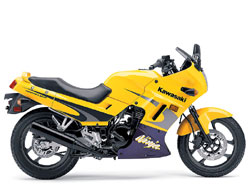|
Description:

NINJA® 250R: The smallest of Kawasaki’s sportbikes is the NINJA® 250R. It delivers big performance and loads of styling, including three different color choices, wrapped in an attractively priced package.
The 250R is powered by a liquid-cooled, in-line twin-cylinder four-stroke engine, with dual overhead cams and four valves per cylinder. This unintimidating, yet high-output engine delivers smooth, predictable power that’s perfect for the sport’s new initiates. And at the same time, more seasoned riders will find the NINJA 250R an exciting experience, thanks to its 14,000-rpm redline and six-speed transmission.
The bike’s lightweight and compact design is what makes this NINJA motorcycle a real joy for riders of all skill levels. It has a low seat height for confidence at stops, an electric starter and Kawasaki’s UNI-TRAK® progressive rear suspension system, similar to that found on the larger-displacement NINJA models.
The finishing touches scream classic NINJA style, complete with an aerodynamic fairing, easy-to-read instrumentation, centerstand, pop-up bungee hooks and a coolant temperature gauge. The NINJA 250R is Kawasaki NINJA® performance in a compact package and at a great price.
– Compact DOHC Twin cylinder engine. 4 valves per cylinder. Lightweight alloy cylinder head. High-compression, lightweight alloy pistons. Advanced liquid-cooling.
– Maintenance chores are minimized with an automatic cam chain tensioner, silent-type cam chain, low-friction coating on chain guides, plus a low-maintenance battery.
– Easy-to-select 6-speed transmission with Kawasaki’s convenient Positive Neutral Finder.
– Diamond high-tensile steel frame and advanced suspension components including the single shock UNI-TRAK® rear suspension system.
– Stainless steel disc brakes front and rear. Balanced Actuation front brake caliper for consistent wear and performance.
– Light overall dry weight, low seat height, electric starter, rider-friendly ergonomics, and a 4 gallon (18 L) fuel tank make the 250R a great introduction to the world of sportbikes.
– Comprehensive instrumentation includes large speedometer and tachometer.
– Retractable bungee cord hooks add convenience and style.
– Kawasaki
With a high-output engine nestled in a lightweight, compact chassis, the Kawasaki Ninja 250R sportbike makes a perfect starting point for budding motorcyclists. The Ninja 250R offers the legendary performance and aggressive styling that only a Kawasaki Ninja motorcycle can provide at an economical price, making it the ideal choice for new sportbike enthusiasts.
|
|
Notes:
MBG Says: (Rating 6.5/10) (year 2000+) There is little doubt that this revision will improve all handling aspects of the little Ninja. Since the engine remains the same, performance should be similar. However, the pricing problem of the old model remains since there is a multitude of choices in both new and used mounts – much more interesting for novices. The Ninja 500R, at only $650 more, is a perfect example.
UMG Says: Similar mill to the GPX bunged into modern chassis, nice styling, but the motor combines gutless low rev behaviour with lack of kicks at the top end. Engine neglect could ruin the motor in 20k but some run to twice that with the top end going first. Overall finish’s a good guide to how the bike’s been abused.
IGM Says (Best buy, Best first bike): This is the most motorcycle you can buy in this price range. Although this is only a 250, its high-tech liquid cooled parallel twin has enough power for freeway riding.
IGM Says: This is the same bike as the 250 Ninja that Kawasaki sold until 1999, and it hasn’t changed much since its introduction in 1986-1999 except for the graphics. If the new bike is a best buy, the used version is even better.
|


